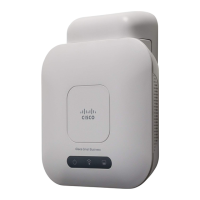Wireless
Radio
Cisco WAP571/E Administration Guide 79
5
- On—A station is required to send a TSPEC request for bandwidth to the
WAP device before sending or receiving a voice traffic stream. The WAP
device responds with the result of the request, which includes the
allotted medium time if the TSPEC was admitted.
- Off—A station can send and receive voice priority traffic without
requiring an admitted TSPEC; the WAP device ignores voice TSPEC
requests from client stations.
• TSPEC Voice ACM Limit—The upper limit on the amount of traffic the WAP
device attempts to transmit on the wireless medium using a voice AC to gain
access. The default limit is 20 percent of total traffic.
• TSPEC Video ACM Mode —Regulates mandatory admission control for the
video access category. By default, TSPEC Video ACM mode is off. The
options are:
- On — A station is required to send a TSPEC request for bandwidth to the
WAP device before sending or receiving a video traffic stream. The WAP
device responds with the result of the request, which includes the
allotted medium time if the TSPEC was admitted.
- Off — A station can send and receive video priority traffic without
requiring an admitted TSPEC; the WAP device ignores video TSPEC
requests from client stations.
• TSPEC Video ACM Limit—The upper limit on the amount of traffic that the
WAP device attempts to transmit on the wireless medium using a video AC
to gain access. The default limit is 15 percent of total traffic.
• TSPEC AP Inactivity Timeout—The amount of time for a WAP device to
detect a downlink traffic specification as idle before deleting it. The valid
integer range is from 0 to 120 seconds and the default is 30 seconds.
• TSPEC Station Inactivity Timeout—The amount of time for a WAP device
to detect an uplink traffic specification as idle before deleting it. The valid
integer range is from 0 to 120 seconds and the default is 30 seconds.
• TSPEC Legacy WMM Queue Map Mode—Enables or disables the
intermixing of legacy traffic on queues operating as ACM. By default, this
mode is off.
• TurboQAM—The purpose of this feature is to enabled/disable Broadcom
specific extensions in VHT for Broadcom-to-Broadcom links. VHT feature
enables support for 256QAM VHT rates not specified by the 802.11ac Draft.
The rates are all VHT LDPC mode, MCS 9 Nss 1 20Mhz, MCS 9 Nss 2 20Mhz,
MCS 6 Nss 3 80Mhz. The VHT feature is supported for 802.11ac PHY.

